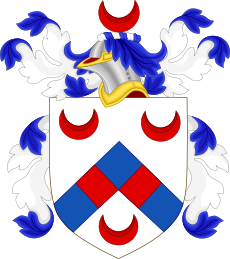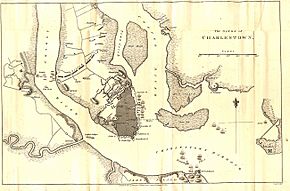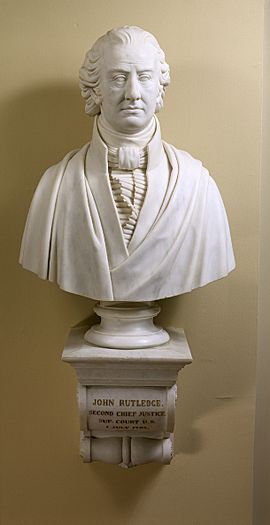John Rutledge facts for kids
Quick facts for kids
John Rutledge
|
|
|---|---|
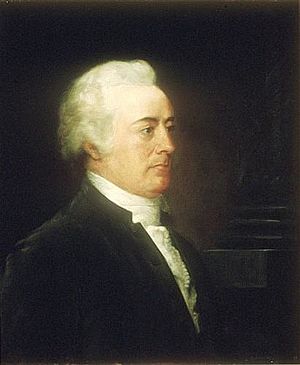
Portrait by John Trumbull
|
|
| 2nd Chief Justice of the United States | |
| In office August 12, 1795 – December 28, 1795 |
|
| Nominated by | George Washington |
| Preceded by | John Jay |
| Succeeded by | Oliver Ellsworth |
| Associate Justice of the Supreme Court of the United States | |
| In office February 15, 1790 – March 5, 1791 |
|
| Nominated by | George Washington |
| Preceded by | Position established |
| Succeeded by | Thomas Johnson |
| 31st Governor of South Carolina | |
| In office January 9, 1779 – January 16, 1782 |
|
| Lieutenant | Thomas Bee Christopher Gadsden |
| Preceded by | Rawlins Lowndes |
| Succeeded by | John Mathews |
| In office July 4, 1776 – March 7, 1778 as President of South Carolina |
|
| Vice President | Henry Laurens James Parsons |
| Preceded by | Henry Laurens (as President of the Committee on Safety) |
| Succeeded by | Rawlins Lowndes |
| Delegate from South Carolina to the Continental Congress |
|
| In office September 5, 1774 – October 26, 1776 |
|
| Delegate from South Carolina to the Stamp Act Congress |
|
| In office October 7, 1765 – October 25, 1765 |
|
| Member of the South Carolina Commons House of Assembly | |
| In office 1761–1775 |
|
| Attorney General of South Carolina | |
| In office 1764–1764 |
|
| Monarch | George III |
| Preceded by | James Moultrie |
| Succeeded by | Egerton Leigh |
| Personal details | |
| Born | September 17, 1739 Charleston, South Carolina, British America |
| Died | June 21, 1800 (aged 60) Charleston, South Carolina, U.S. |
| Resting place | St. Michael's Churchyard |
| Political party | Federalist |
| Spouse |
Elizabeth Grimké
(m. 1763; died 1792) |
| Children | 10 |
| Relatives | Edward Rutledge (brother) |
| Education | Middle Temple |
| Signature | |
John Rutledge (born September 17, 1739 – died June 21, 1800) was an important American Founding Father, a politician, and a judge. He was one of the first associate justices of the Supreme Court and later became the second chief justice.
Rutledge was also the first president of South Carolina and then its first governor after the Declaration of Independence. He was born in Charleston, South Carolina, and studied law in London. He became a successful lawyer.
He played a key role in the Stamp Act Congress, which protested unfair taxes from Britain. He also attended the Continental Congress, where he helped unite the colonies. During the American Revolutionary War, he served as governor of South Carolina.
Later, Rutledge was a delegate at the 1787 Philadelphia Convention, where the U.S. Constitution was written. He led the committee that created the first draft of the Constitution.
In 1789, President George Washington chose Rutledge to be one of the first Supreme Court justices. He left the Supreme Court in 1791 but returned as chief justice in 1795. However, the Senate rejected his nomination because of a controversial speech he gave. He holds the record for the shortest time served as chief justice.
Contents
Early Life and Family Background
John Rutledge was the oldest of seven children in a large family from Charleston, South Carolina. His father, John Rutledge Sr., was a doctor from Ireland. His mother, Sarah, was from South Carolina and had English family roots.
John's father taught him at home until he passed away. After that, an Anglican priest continued John's education. John was very interested in law from a young age. He would often pretend to be a lawyer with his brothers and sisters.
When he was 17, John started studying law with a lawyer named James Parsons. Two years later, he traveled to England to continue his legal studies at Middle Temple in London. He even won several cases in English courts while he was there.
After finishing his studies, Rutledge came back to Charleston. He quickly became one of the most successful lawyers in the city. His services were in high demand, and he earned a lot of money.
On May 1, 1763, Rutledge married Elizabeth Grimké. He cared deeply for his wife. Her death in 1792 greatly affected his health in his later years. John and Elizabeth had 10 children together.
Before the Revolutionary War
From 1761 to 1775, Rutledge was a member of South Carolina's local government, called the Commons House of Assembly. He became one of its most important leaders.
Rutledge played a big part in the 1765 Stamp Act Congress. This meeting was held to protest new taxes that the British Parliament placed on the American colonies. The Congress declared that British people had the right to only be taxed if they agreed to it through their representatives.
Rutledge led a group that wrote a petition to the British House of Lords. They tried to convince them to get rid of the Stamp Act, but they were not successful.
When the delegates returned to South Carolina, they found the colony in chaos. People were destroying tax stamps and searching homes of those they thought supported the British. When the Stamp Act officially started on November 1, 1765, there were no stamps left in South Carolina. All legal activities stopped until the Stamp Act was canceled in May 1766.
After this conflict, Rutledge went back to his private law practice. He stayed out of politics, except for his work in the colonial legislature. His law practice grew, and he became quite wealthy.
In 1774, Rutledge was chosen to represent South Carolina at the First Continental Congress. This meeting brought together leaders from different colonies to discuss their problems with Britain.
Leading South Carolina
Rutledge served in the First and Second Continental Congress until 1776. That year, he was elected president of South Carolina under a new state constitution. As president, he quickly worked to set up the new government and prepare for British attacks.
In early 1776, Rutledge learned that British forces planned to attack Charleston. He ordered the building of Fort Sullivan (now Fort Moultrie) on Sullivan's Island. When the British arrived, the fort was only half-finished.
General Charles Lee of the Continental Army told Rutledge to leave the fort, saying it couldn't be defended. But Rutledge, who controlled the state's militia, insisted on defending Charleston. He earned the nickname "Dictator John" because he was so determined.
On June 28, 1776, the British attacked. However, the fort's walls were made of soft palmetto logs packed with sand. British cannonballs sank into the logs without causing much damage. The British were defeated, and Charleston was saved. This victory is still celebrated as "Carolina Day" every June 28. South Carolina's state flag, the "Palmetto Flag", features the palmetto tree and a crescent symbol from the soldiers' caps.
Rutledge remained president of South Carolina until 1778. That year, the state legislature suggested a new constitution. Rutledge disagreed with it, believing it would lead to too much direct democracy, which he thought could cause chaos. When the legislature passed it anyway, Rutledge resigned.
Serving as Governor
A few months after Rutledge resigned, the British decided to focus their efforts on the Southern colonies. In 1779, Rutledge was elected governor of South Carolina. He is considered the 31st governor, including the colonial leaders.
Rutledge sent troops to fight the British in Georgia. In response, British General Jacques Prevost marched towards Charleston with 2,500 soldiers. Rutledge rushed to Charleston and worked hard to build up its defenses.
When General Prevost arrived, his forces had grown much larger with the help of Loyalists (people who supported the British). The Americans were greatly outnumbered. Rutledge secretly asked Prevost for surrender terms. However, his war council refused to surrender and decided to fight. The next morning, the British had left. Prevost had learned that American reinforcements were coming and decided to retreat.
Charleston Under Siege
In early 1780, British General Sir Henry Clinton attacked South Carolina, causing panic in Charleston. The state legislature gave Rutledge special powers to do anything needed to defend the state, except for executions without trial. Rutledge tried to gather more militia, but a smallpox outbreak in the city made it difficult.
By May, Clinton had 9,000 troops against fewer than 2,500 Americans. Charleston was under siege. On May 10, Charleston surrendered, but Rutledge had already left the city. He continued to govern the parts of South Carolina that the British had not conquered.
The Americans eventually pushed the British back to Charleston in June 1781. The British held Charleston until December 14, 1782. Rutledge's term as governor ended, and he did not run again due to term limits. A few weeks later, he was elected to the Continental Congress again, serving until 1783. In 1784, he became a judge on the South Carolina Court of Chancery.
Helping Write the Constitution
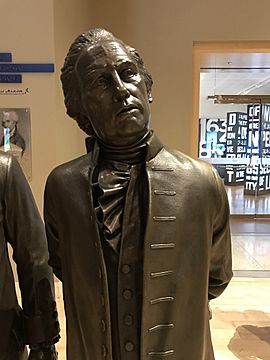
In 1787, John Rutledge was chosen to represent South Carolina at the Philadelphia Convention. This meeting was meant to fix the Articles of Confederation, but instead, it created the United States Constitution. Rutledge attended all the meetings and served on five important committees.
At the Convention, Rutledge supported a strong national government. He led the Committee of Detail, which was responsible for writing the first full draft of the Constitution. This committee used ideas from earlier plans and the Convention's decisions to create the draft. Many of the details included in this first draft, like the powers of Congress, were later included in the final Constitution without much debate.
Rutledge believed that the country's leader (the president) should be a single person. He felt that one person would take more responsibility for decisions. He also thought that judges should only make decisions on actual legal cases, not give general advice.
When some delegates suggested that only landowners should be allowed to vote, Rutledge strongly opposed it. He argued that such a rule would divide people and cause anger. His view, supported by Benjamin Franklin, helped ensure that the rule was not adopted.
During the debates about slavery, Rutledge, who owned slaves, argued that Southern states would not agree to the Constitution if it banned slavery. He said that these states would never give up such an important interest. Because of this, a compromise was reached: the international slave trade would not be stopped before 1808. Also, the Fugitive Slave Clause was added to the Constitution, requiring that enslaved people who escaped to other states be returned.
Rutledge received some votes in the first U.S. presidential election in 1788–1789.
Time on the Supreme Court
Associate Justice
On September 24, 1789, President George Washington nominated John Rutledge to be one of the first five associate justices on the new Supreme Court. The Senate approved his appointment two days later. He officially started his service on February 15, 1790, and left on March 5, 1791. Rutledge resigned from the Supreme Court without hearing any cases. He wanted to become the chief justice of the South Carolina Court of Common Pleas and Sessions.
Chief Justice
On June 28, 1795, Chief Justice John Jay resigned. President Washington chose Rutledge to replace him. Since the Senate was not meeting, Washington gave Rutledge a "recess appointment." This allowed Rutledge to serve as chief justice right away during the upcoming August session. He officially became chief justice on June 30, 1795, and took his oath on August 12.
On July 16, 1795, Rutledge gave a very controversial speech. He spoke strongly against the Jay Treaty, an agreement with Great Britain. He reportedly said he would rather the President die than sign such a "childish" agreement. This speech cost him the support of many in Washington's government and in the Senate. The Senate would soon vote on his official nomination.
Two cases were decided while Rutledge was chief justice. In United States v. Peters, the Court ruled that federal courts did not have power over crimes committed against Americans in international waters. In Talbot v. Janson, the Court decided that a U.S. citizen did not lose their U.S. citizenship by giving up citizenship in a single state or by becoming a citizen of another country. This case helped set an important rule for multiple citizenship in the United States.
By the time his official nomination reached the Senate on December 10, 1795, Rutledge's reputation was damaged. Rumors of mental illness spread, mainly from newspapers that supported the Federalist Party. His strong words against the Jay Treaty were used as proof of his declining health. On December 15, 1795, the Senate rejected his appointment by a vote of 10 to 14. This was the first time the Senate had ever voted down a Supreme Court nomination.
Rutledge resigned from the Court on December 28, 1795. He served the shortest time of any Chief Justice of the United States. He is also the only Supreme Court justice appointed during a Senate recess who was later rejected by the Senate.
Later Years and Legacy
After 1795, John Rutledge left public life and returned to Charleston. He stayed out of politics, except for serving one term in the South Carolina House of Representatives.
He passed away on June 21, 1800, at the age of 60. He was buried at St. Michael's Episcopal Church in Charleston. One of his former homes, built in 1763, was renovated in 1989 and is now open to the public as the John Rutledge House Inn.
Views on Slavery
Like many wealthy white people in the Southern states at that time, John Rutledge owned slaves. Other Founding Fathers, such as George Washington and Thomas Jefferson, also owned slaves.
During the Revolutionary War, Rutledge gave orders to an officer, Francis Marion, to execute Black people suspected of helping the British.
At the Constitutional Convention in 1787, Rutledge strongly defended slavery. He argued that if the Constitution banned slavery, the Southern states like North Carolina, South Carolina, and Georgia would not agree to join the new United States. He believed the people in those states would not give up such an important interest.
As a result, a compromise was made between the Northern and Southern states. The international slave trade was allowed to continue until 1808 (as stated in Article 1, Section 9 of the Constitution). Also, the Fugitive Slave Clause was added (in Article 4, Section 2), which required that enslaved people who ran away to other states be returned to their owners.
Images for kids
See also
 In Spanish: John Rutledge para niños
In Spanish: John Rutledge para niños


